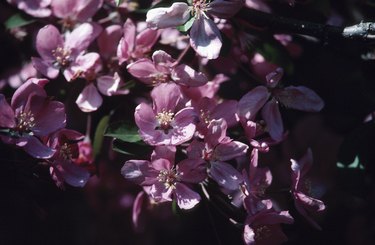
Crab apple trees are known for their beautiful flower blossoms, and are commonly used for landscaping and property beautification. Although they come with pretty and colorful displays, crab apple trees are very susceptible to insects and tree diseases. A dying crab apple tree has several symptoms, depending on which disease is targeting it. Understanding tree diseases can give homeowners a helpful way of recognizing signs that their crab apple tree may be dying.
Apple Scab
Video of the Day
Apple scab fungus is caused by spores that are blown from infected leaves and trees. Signs of apple scab disease include yellow to brown lesions on the leaf surface and leaves falling off prematurely. Normal leaf fall for apple trees is seen in mid-August and early September. Apple scab can cause leaves to fall as early as May. Apple scab fungus misshapes and disfigures apple fruit, causing it to be inedible. Persistent apple scab infections can weaken the tree, leaving it susceptible to other diseases and insects. Frequent infestations and secondary diseases can cause a tree to die, as it is unable to fight off further problems.
Video of the Day
Fire blight
Fire blight is a serious apple tree disease that starts from apple blossoms and moves to the twigs and branches. Fire blight is recognized by the burnt appearance on twigs and branches. Flowers will turn brown and wilt, while twigs shrivel up and blacken. The ends of twigs curl up as they die. Oozing patches or cankers show on branches, and the discharge is translucent amber or reddish in color. Oozing is seen in severe bacterial infestations and means that a bad case of bacteria is present. Fire blight is a disease that starts to kill the tree from the inside out. As there is no cure for fire blight, it is important to immediately remove dying and infected twigs or branches. This stops the disease from spreading and the rest of the tree from dying out. Burn cut-off and infected branches to stop the bacteria from spreading to healthy trees.
Wetwood
Wetwood is another crab apple tree disease that causes cankers, and slimy ooze to come out of the joints (where the trunk meets the branches). Wetwood disease is caused by bacteria that enters through holes left by insects, and causes rotting from the inside out. Wetwood is serious enough that infected trees need to be removed and destroyed. Weakening of branches can pose a serious threat of injury or property damage.